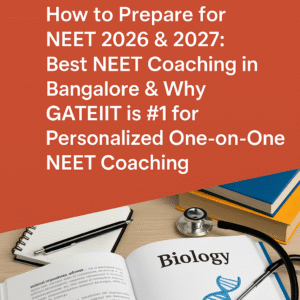Introduction
The National Eligibility cum Entrance Test (NEET) is India’s premier medical entrance examination, determining admissions into MBBS, BDS, and other undergraduate medical courses across the country. Since its inception in 2013, NEET has been administered exclusively as a pen-and-paper test—an offline, OMR-based examination. In an era where digital transformation has permeated nearly every sphere of life, many stakeholders—students, educators, parents, and policymakers—have questioned why NEET remains offline. With advancements in online proctoring, secure browser technologies, and digital infrastructure, why has India’s most critical medical entrance test not transitioned to an online format?
This blog delves into the multifaceted reasons behind NEET’s continued offline administration. We will explore historical, technical, logistical, socio-economic, and regulatory factors that make the offline format the preferred—and in many ways, the only feasible—option for India’s vast and diverse candidate pool.
1. Historical Context and Evolution of NEET
- Genesis of a Unified Entrance Exam
- Prior to 2013, medical admissions were fragmented across states and universities, each conducting its own entrance tests (e.g., AIPMT, state-level exams).
- The Supreme Court mandated a unified national entrance test to curb malpractices and standardize admissions.
- Given the scale and urgency, an offline OMR-based test model was a natural choice, leveraging existing infrastructure.
- Early Phase and Infrastructure Setup
- In the first years (2013–2016), NEET was administered through approximately 1,000 centres nationwide.
- Offline mode allowed leveraging schools, colleges, and examination halls equipped for paper-based testing.
- Authorities could deploy standardized question booklets and OMR sheets, minimizing technical dependencies.
- Stakeholder Familiarity and Acceptance
- Students, educators, and administrators were already accustomed to board examinations (CBSE, State Boards) conducted offline.
- Transitioning to online mode would have required massive reorientation—training staff, acclimatizing students, and overhauling administrative processes.
2. Technical and Logistical Challenges
- Scale of the Examination
- NEET typically sees over 2 million candidates in a single day across more than 4,000 centers.
- Ensuring uninterrupted internet connectivity, power backup, and functional hardware at every center is a colossal logistical challenge.
- Digital Infrastructure Disparity
- Urban centers may enjoy robust internet, but many rural and semi-urban regions face erratic connectivity and frequent power cuts.
- An online NEET would risk disadvantageous students from remote areas who lack reliable networks or computers.
- Hardware Standardization
- Different centers possess varying hardware capabilities—older computers, diverse operating systems, and differing security configurations.
- Ensuring uniformity in performance (screen latency, input responsiveness) across hundreds of thousands of machines is practically infeasible.
- Exam Day Contingencies
- In offline tests, unforeseen events (e.g., network outage, software glitch) have no bearing on paper-based exams.
- Online mode introduces vulnerabilities: server downtime, denial-of-service attacks, or malicious software could jeopardize the exam’s integrity.
3. Security, Fairness, and Integrity
- Preventing Malpractices
- Offline OMR exams allow invigilators to monitor candidates in person, reducing the risk of cheating through unauthorized devices.
- Online exams would require advanced AI-driven proctoring tools, raising concerns about efficacy and privacy.
- Question Paper Security
- In a synchronized offline exam, sealed question booklets and OMR sheets are distributed under strict chain-of-custody protocols.
- For online NEET, ensuring that question papers are not leaked beforehand would necessitate end-to-end encryption, tamper-proof servers, and real-time monitoring—complex to implement at scale.
- Uniform Testing Conditions
- Offline mode guarantees every candidate experiences the same testing environment—same lighting, seating arrangement, and exam timing.
- Online conditions vary widely: noise levels, ambient light, ergonomic seating—all factors that can impact performance.
- Data Privacy and Ethical Concerns
- Online proctoring often involves continuous video/audio surveillance, screen recording, and biometric monitoring.
- Such measures raise privacy issues and can disproportionately affect candidates uncomfortable with intrusive monitoring.
4. Socio-Economic Considerations
- Digital Divide
- A significant portion of NEET aspirants come from economically disadvantaged backgrounds.
- Expecting candidates to own or access personal computers, webcams, and high-speed internet is unrealistic.
- Affordability of Test Centers
- Establishing and maintaining ‘computer labs’ at every exam center would inflate costs.
- Fee hikes to cover technological investments could make NEET coaching prohibitively expensive for many families.
- Inclusivity and Accessibility
- Offline exams are inherently more inclusive—candidates with visual impairments or other disabilities are already accommodated via standard protocols (scribes, extra time).
- Online platforms may not yet offer universally accessible interfaces for differently-abled candidates.
- Cultural and Psychological Factors
- Indian students are culturally more comfortable with pen-and-paper tests, having practiced extensively through board exams.
- Sudden shift to typing answers (for sections like reasoning) could induce anxiety and hamper performance.
5. Regulatory and Policy Framework
- Government Directives
- The Medical Council of India (MCI), replaced by the National Medical Commission (NMC), continues to endorse the offline format for NEET.
- Policy inertia and the weight of established procedures impede rapid format changes.
- Standard Operating Procedures (SOPs)
- Decades of SOPs govern printing, distribution, invigilation, answer key generation, and result processing for offline exams.
- Rewriting SOPs for online administration would require inter-ministerial coordination (Education, IT, Home Affairs) and extensive pilot testing.
- Judicial Oversight
- NEET’s format has been subject to legal challenges and injunctions. Any shift to online would inevitably face petitions concerning fairness, accessibility, and technical glitches.
- Stakeholder Consensus
- Medical aspirant bodies, coaching institutes, state governments, and universities all have a say. Achieving consensus on a digital overhaul could take years.
6. Comparative Analysis: Offline vs. Online Entrance Exams
| Aspect | Offline NEET | Hypothetical Online NEET |
| Infrastructure | Utilizes existing classrooms and halls | Requires extensive computer labs and IT setup |
| Security | In-person invigilation, sealed booklets | AI proctoring, encryption, server security |
| Accessibility | High (pen-paper familiar) | Variable (digital literacy dependent) |
| Cost to Conduct | Moderate (printing, logistics) | High (hardware, software licenses, training) |
| Candidate Convenience | Centralized exam centers | May allow remote participation—but with caveats |
| Risk of Technical Failure | Low | High |
| Data Privacy Concerns | Minimal | Significant (constant surveillance) |
7. Future Prospects for NEET
- Pilot Online Modules
- NTA could introduce optional online mock tests, acclimatizing students and administrators to the digital format.
- Data from these pilots will inform policy decisions.
- Phased Rollout Strategy
- Urban centers with robust infrastructure might host dual-mode exams, allowing comparison of offline vs. online performance metrics.
- Lessons learned can guide scaling to wider geographies.
- Investing in Infrastructure
- Public–private partnerships could refurbish government schools as digital exam centers, benefiting NEET and other competitive exams.
- Enhanced Security Protocols
- Development of blockchain-based question paper distribution and biometric authentication to ensure integrity.
- Evolving Candidate Expectations
- As digital natives enter the aspirant pool, demand for online examinations may increase, pressuring authorities to adapt.
8. How GATEIIT Helps Students Excel in Offline NEET
- Simulated Full-Length Mock Tests
- GATEIIT conducts weekly offline mock exams under real NEET-like conditions—same OMR sheets, time constraints, and invigilation standards.
- Detailed performance analytics help students identify strengths and weaknesses.
- Comprehensive Study Material
- Exhaustive printed materials—topic-wise concept booklets, previous years’ solved papers, and high-yield revision notes—ensure familiarity with paper-based formats.
- Time Management Workshops
- Specialized sessions on OMR-marking strategies, question-selection techniques, and effective time allocation during the exam.
- Concept Reinforcement Sessions
- Offline doubt-clearing classes with faculty support, fostering interactive group discussions and peer learning.
- Stress Management and Exam Day Readiness
- Mock exam debriefs focus on exam hall etiquette, handling unforeseen situations, and psychological resilience.
- Accessibility and Inclusivity
- GATEIIT centre in JP Nagar 2nd Phase, Bangalore ensures students need not travel long distances to practice under offline conditions.
- Special accommodations (extra time, scribes) are seamlessly integrated into mock tests to mirror actual NEET provisions.
- Parental Engagement and Mentorship
- Regular parent–teacher meets keep families informed about offline exam requirements, logistics, and best practices.
- Continuous Feedback Loop
- Performance dashboards and one-on-one mentoring sessions adjust study plans dynamically, ensuring steady improvement in offline test-taking skills.
Conclusion
While the digital age has ushered in online exams in various sectors, NEET’s offline format persists due to a confluence of historical decisions, massive logistical challenges, security concerns, socio-economic disparities, and regulatory inertia. The pen-and-paper model remains the most reliable, fair, and inclusive method for assessing over two million aspirants from diverse backgrounds every year.
For students aiming to conquer the offline NEET exam, preparedness extends beyond mastering concepts—it demands familiarity with the nuances of paper-based testing. GATEIIT’s targeted offline coaching modules, simulated mocks, and holistic mentorship equip aspirants with the confidence and competence to excel when it matters most. By aligning with NEET’s offline realities, GATEIIT ensures that every student walks into the exam hall ready to make every bubble count.
Embark on your NEET journey with GATEIIT—where offline excellence meets online ambition.



